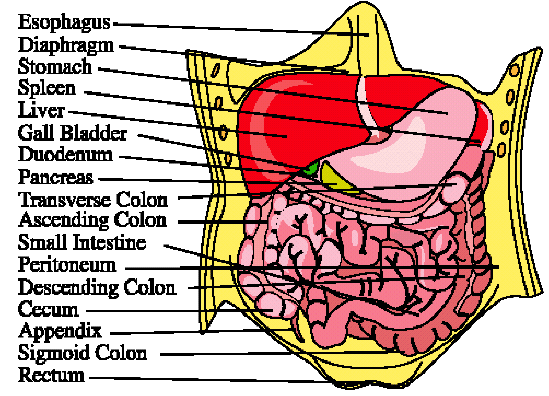BACKGROUND:
A “system” is a group of organs (heart, lungs, liver,
etc) that work together toward one specific function. For example,
some of the organs that make up the digestive system are the stomach, pancreas,
liver, gallbladder, and the small and large intestines. Some of the
systems of the human body include the circulatory, excretory (renal), respiratory,
and nervous.
The digestive system changes food so it can be used by our bodies.
The food is first taken in by the mouth and chewed. The food is then
swallowed and moved down a tube (the esophagus) into the stomach.
Here the stomach muscles contract and the food is mixed with stomach fluids
to further break down the food. Now, the food moves from the stomach
to the small intestine. It is from here that vitamins and digested food
passes into the blood and throughout the body. Water is passed into
the blood through the large intestine. The large intestine
is where water is removed leaving the solid material which cannot be used.
This material is not digested and finally removed as waste through the
anus.
What makes food go down? It is not gravity, because you
can eat and drink lying down. A tiny pulsation of movements of the
muscles called peristaltic motion causes this movement. Help your
students visualize this motion by using a soft plastic tube with a marble
that just fits in the tube. Instruct the students to push it
through the tube. They will experience peristaltic motion.
The nourishment from the digestive system goes into the blood stream which
distributes it to the cells. What the cells can not use becomes liquid
waste. The body removes this liquid through the lungs, perspiration,
kidneys, and bladder. The kidney acts as a filter. Once
the waste is filtered the kidneys send back to the blood stream what is
still usable, and the liquid waste is sent out to the bladder via two tubes
called ureters. In the bladder the liquid called urine is stored
until there is enough urine for the body to eliminate.
The liver’s main function is to produce digestive juices and
enzymes for our body. The pancreas produces a substance that neutralizes
the strong acid from the stomach.
PROCEDURE:
- Give students the two worksheets. Have
them cut out one set and color them.
- Students should then paste the organs in their correct
position. Please note that these organs may be partly hidden when
looking from the front of a person.
ANSWERS: 1. STOMACH, 2. LIVER (dotted line is gall bladder), 3. PANCREAS,
4. SMALL INTESTINES, 5. LARGE INTESTINES
